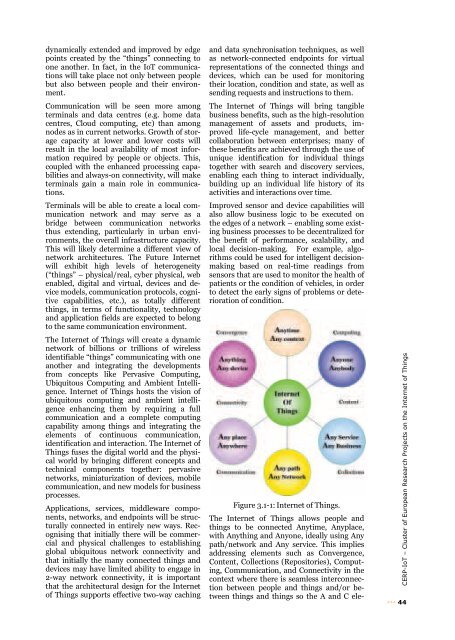Vision and Challenges for Realising the Internet of Things
Vision and Challenges for Realising the Internet of Things
Vision and Challenges for Realising the Internet of Things
You also want an ePaper? Increase the reach of your titles
YUMPU automatically turns print PDFs into web optimized ePapers that Google loves.
dynamically extended <strong>and</strong> improved by edge<br />
points created by <strong>the</strong> “things” connecting to<br />
one ano<strong>the</strong>r. In fact, in <strong>the</strong> IoT communications<br />
will take place not only between people<br />
but also between people <strong>and</strong> <strong>the</strong>ir environment.<br />
Communication will be seen more among<br />
terminals <strong>and</strong> data centres (e.g. home data<br />
centres, Cloud computing, etc) than among<br />
nodes as in current networks. Growth <strong>of</strong> storage<br />
capacity at lower <strong>and</strong> lower costs will<br />
result in <strong>the</strong> local availability <strong>of</strong> most in<strong>for</strong>mation<br />
required by people or objects. This,<br />
coupled with <strong>the</strong> enhanced processing capabilities<br />
<strong>and</strong> always-on connectivity, will make<br />
terminals gain a main role in communications.<br />
Terminals will be able to create a local communication<br />
network <strong>and</strong> may serve as a<br />
bridge between communication networks<br />
thus extending, particularly in urban environments,<br />
<strong>the</strong> overall infrastructure capacity.<br />
This will likely determine a different view <strong>of</strong><br />
network architectures. The Future <strong>Internet</strong><br />
will exhibit high levels <strong>of</strong> heterogeneity<br />
(“things” – physical/real, cyber physical, web<br />
enabled, digital <strong>and</strong> virtual, devices <strong>and</strong> device<br />
models, communication protocols, cognitive<br />
capabilities, etc.), as totally different<br />
things, in terms <strong>of</strong> functionality, technology<br />
<strong>and</strong> application fields are expected to belong<br />
to <strong>the</strong> same communication environment.<br />
The <strong>Internet</strong> <strong>of</strong> <strong>Things</strong> will create a dynamic<br />
network <strong>of</strong> billions or trillions <strong>of</strong> wireless<br />
identifiable “things” communicating with one<br />
ano<strong>the</strong>r <strong>and</strong> integrating <strong>the</strong> developments<br />
from concepts like Pervasive Computing,<br />
Ubiquitous Computing <strong>and</strong> Ambient Intelligence.<br />
<strong>Internet</strong> <strong>of</strong> <strong>Things</strong> hosts <strong>the</strong> vision <strong>of</strong><br />
ubiquitous computing <strong>and</strong> ambient intelligence<br />
enhancing <strong>the</strong>m by requiring a full<br />
communication <strong>and</strong> a complete computing<br />
capability among things <strong>and</strong> integrating <strong>the</strong><br />
elements <strong>of</strong> continuous communication,<br />
identification <strong>and</strong> interaction. The <strong>Internet</strong> <strong>of</strong><br />
<strong>Things</strong> fuses <strong>the</strong> digital world <strong>and</strong> <strong>the</strong> physical<br />
world by bringing different concepts <strong>and</strong><br />
technical components toge<strong>the</strong>r: pervasive<br />
networks, miniaturization <strong>of</strong> devices, mobile<br />
communication, <strong>and</strong> new models <strong>for</strong> business<br />
processes.<br />
Applications, services, middleware components,<br />
networks, <strong>and</strong> endpoints will be structurally<br />
connected in entirely new ways. Recognising<br />
that initially <strong>the</strong>re will be commercial<br />
<strong>and</strong> physical challenges to establishing<br />
global ubiquitous network connectivity <strong>and</strong><br />
that initially <strong>the</strong> many connected things <strong>and</strong><br />
devices may have limited ability to engage in<br />
2-way network connectivity, it is important<br />
that <strong>the</strong> architectural design <strong>for</strong> <strong>the</strong> <strong>Internet</strong><br />
<strong>of</strong> <strong>Things</strong> supports effective two-way caching<br />
<strong>and</strong> data synchronisation techniques, as well<br />
as network-connected endpoints <strong>for</strong> virtual<br />
representations <strong>of</strong> <strong>the</strong> connected things <strong>and</strong><br />
devices, which can be used <strong>for</strong> monitoring<br />
<strong>the</strong>ir location, condition <strong>and</strong> state, as well as<br />
sending requests <strong>and</strong> instructions to <strong>the</strong>m.<br />
The <strong>Internet</strong> <strong>of</strong> <strong>Things</strong> will bring tangible<br />
business benefits, such as <strong>the</strong> high-resolution<br />
management <strong>of</strong> assets <strong>and</strong> products, improved<br />
life-cycle management, <strong>and</strong> better<br />
collaboration between enterprises; many <strong>of</strong><br />
<strong>the</strong>se benefits are achieved through <strong>the</strong> use <strong>of</strong><br />
unique identification <strong>for</strong> individual things<br />
toge<strong>the</strong>r with search <strong>and</strong> discovery services,<br />
enabling each thing to interact individually,<br />
building up an individual life history <strong>of</strong> its<br />
activities <strong>and</strong> interactions over time.<br />
Improved sensor <strong>and</strong> device capabilities will<br />
also allow business logic to be executed on<br />
<strong>the</strong> edges <strong>of</strong> a network – enabling some existing<br />
business processes to be decentralized <strong>for</strong><br />
<strong>the</strong> benefit <strong>of</strong> per<strong>for</strong>mance, scalability, <strong>and</strong><br />
local decision-making. For example, algorithms<br />
could be used <strong>for</strong> intelligent decisionmaking<br />
based on real-time readings from<br />
sensors that are used to monitor <strong>the</strong> health <strong>of</strong><br />
patients or <strong>the</strong> condition <strong>of</strong> vehicles, in order<br />
to detect <strong>the</strong> early signs <strong>of</strong> problems or deterioration<br />
<strong>of</strong> condition.<br />
Figure 3.1-1: <strong>Internet</strong> <strong>of</strong> <strong>Things</strong>.<br />
The <strong>Internet</strong> <strong>of</strong> <strong>Things</strong> allows people <strong>and</strong><br />
things to be connected Anytime, Anyplace,<br />
with Anything <strong>and</strong> Anyone, ideally using Any<br />
path/network <strong>and</strong> Any service. This implies<br />
addressing elements such as Convergence,<br />
Content, Collections (Repositories), Computing,<br />
Communication, <strong>and</strong> Connectivity in <strong>the</strong><br />
context where <strong>the</strong>re is seamless interconnection<br />
between people <strong>and</strong> things <strong>and</strong>/or between<br />
things <strong>and</strong> things so <strong>the</strong> A <strong>and</strong> C ele-<br />
CERP-IoT – Cluster <strong>of</strong> European Research Projects on <strong>the</strong> <strong>Internet</strong> <strong>of</strong> <strong>Things</strong><br />
44
















